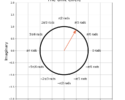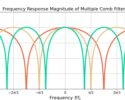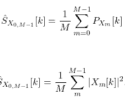Table of Contents
Introduction
The Design of Everyday Things by Donald Norman has had a profound impact on my engineering career. Why should a DSP or RF engineer read a book about light switches, door knobs and telephone keypads? Read on to find out!
Check out these other blogs!

Mental Models
I read The Design of Everyday Things when I was getting my MSEE and it completely changed how I thought about designing, engineering, and communication.
As a student I found it difficult to communicate complicated thoughts such as ![]() , what a signal’s phase is, or why the Discrete Fourier Transform (DFT) works. I understood the concepts but I could not explain them to anyone else.
, what a signal’s phase is, or why the Discrete Fourier Transform (DFT) works. I understood the concepts but I could not explain them to anyone else.
The book introduces the powerful concept of a ”mental model”. The user of an object needs to have an understanding of how it works and a simple understanding is best. It is the job of the designer (or engineer) to design the system to be clear and intuitive. Complex and difficult to understand objects and systems will cause the user to feel dumb and thus the object will be discarded. Fail!
Simplify when Communcating
DSP and RF engineers do not design products that interface directly with humans. Typically DSP and RF engineers are designing hardware, software or algorithms which interface with other electronics.
However!
Engineers still have to communicate their thoughts, ideas and plans to their customers, co-workers, program managers and other people involved in the product of a system.
Using lessons learned from Everyday Things, provide everyone interested and invested in your work with mental models. Describe the operation using simple language and simple concepts to drive the point home. In many cases it will be useful to over simplify, leaving out detailed information about the operation which the user may not be prepared for or have time to discuss.
How do you provide a simple mental model?
1. Use pictures and images whenever possible to communicate
2. Use math to support and justify your work, but do not use it to explain your work. Math is hard to understand for broad swaths of the population and your audience may not have the same mathematical expertise and experience as you do.
Examples of Mental Models
A mental model paradox: the most accurate technical descriptions of a system is often too difficult to understand for the user and it should not be communicated to them. The best mental models are so over-simplified that they begin to lose information and present a some-what inaccurate representation.
Let’s take a look at a two examples, both describing the operation of an automobile.
Bad mental model: a car requires a highly coordinated symbiotic dance between the fuel combustion system, the electric system and the mechanical systems. The battery provides the energy to start the ignition, beginning the combustion process and starting the mechanical movement. Once the engine is running the alternator will convert physical movement into electrical energy by rotating magnets around a coil, causing a change in the magnetic flux which creates current in the coil, which is used to recharge the battery. Pressing the gas pedal increases the amount of fuel injected into the engine, increasing the energy created into combustion and propelling the vehicle faster. The brake pedal converts excess velocity into heat by pressing the brake pad against the brake disc, converting kinetic energy into heat through friction and stopping the vehicle.
Good mental model: put the key in, then press the gas pedal to go forward, and press the brake to stop.
Conclusion
The Design of Everyday Things is an incredible book for engineers and I highly suggest buying a copy. The book introduces the concept of a mental model which describes how people perceive a system operates. Designing systems to have simpler mental models makes them easier to use. DSP and RF engineers can use the mental model concept to describe their systems to their co-workers, program managers and customers in ways that makes them easy to understand.
Check out these other blogs!








